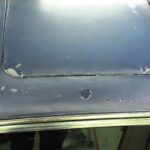The thought of being trapped is universally unsettling, triggering immediate feelings of panic. Now, picture this: you’re stuck inside your car, which has flipped upside down after an accident or is rapidly sinking in water. It’s a terrifying scenario, thankfully rare. While these types of incidents are not common – data from 2017 estimates around 8,000 cases of vehicle submersion – rollover crashes are significantly more frequent, occurring over ten times as often. In any car emergency, including these extreme situations, survival hinges on one crucial element: preparedness. Staying calm, having a clear plan, and equipping your vehicle with the Best Emergency Escape Tools For Cars can dramatically increase your chances of getting out safely.
Understanding the Need for Car Escape Tools
Although scenarios like car submersion or rollovers might seem unlikely, the potential for any type of car accident is always present. The unexpected nature of emergencies underscores the importance of proactive safety measures. A critical component of this preparedness is having access to effective car escape tools. To provide consumers with reliable information, AAA conducted thorough research to evaluate the effectiveness of various car escape tools in breaking both tempered and laminated automotive glass. Their findings, detailed in a comprehensive report, highlight the capabilities and limitations of these tools, emphasizing their value in specific emergency situations. The core message is clear: equipping your car with the right escape tool isn’t about anticipating the worst, it’s about being intelligently prepared for the unexpected.
Tempered vs. Laminated Glass: Know Your Windows
Understanding the type of glass in your car windows is paramount when considering emergency escape tools. Most vehicles use two types of side window glass: tempered and laminated. Tempered glass is designed to shatter into small, relatively harmless pieces upon impact, which is the type of glass that car escape tools are designed to break. Laminated glass, on the other hand, is constructed with a plastic layer sandwiched between two layers of glass, making it significantly stronger and resistant to shattering. This type of glass is designed to stay intact even when cracked, primarily to prevent occupant ejection during collisions.
AAA’s testing rigorously assessed how well different escape tools performed against both types of glass. The results were revealing: while several tools effectively shattered tempered glass, none could break through laminated glass. In fact, laminated glass remained largely intact even after being cracked multiple times with the tested tools. Furthermore, the research indicated that spring-loaded escape tools generally outperformed hammer-style tools in breaking tempered windows, suggesting a more efficient mechanism for generating the necessary force.
The Rise of Laminated Side Windows
The increasing use of laminated side windows in modern vehicles presents a crucial consideration for drivers relying on car escape tools. While laminated glass offers enhanced safety benefits in preventing ejection and reducing noise, it also poses a challenge in emergency escape situations. AAA’s study highlighted that a growing number of new cars are being manufactured with laminated side windows. Alarmingly, approximately 1 in 3 of the 2018 vehicle models already incorporated laminated side windows. This trend means that relying solely on a standard car escape tool might not be a viable escape strategy for many newer vehicles, as these tools are ineffective against laminated glass.
This shift underscores the importance of knowing exactly what type of side windows your car has. As John Nielsen, Managing Director of Automotive Engineering and Repair for AAA, points out, “To improve safety, more cars have laminated side windows – but a majority also have at least one window made of tempered glass.” This means that while escape tools can be effective, their utility is conditional. Drivers must be aware of their vehicle’s window composition to avoid wasting critical seconds attempting to break glass that is designed not to shatter.
Identifying Your Car’s Window Type
Fortunately, determining the type of glass in your car’s side windows is a straightforward process. The most reliable method is to check for a label typically located in the bottom corner of each side window. This label should clearly indicate whether the glass is “tempered” or “laminated.” Look closely for these markings on all your side windows, as some vehicles may have a combination of both types, for instance, laminated front side windows and tempered rear side windows.
If you are unable to locate a label or the information is unclear, AAA recommends contacting your vehicle manufacturer directly. Your dealer or the manufacturer’s customer service department should be able to provide specific details about the glass type used in your car model. Taking this simple step to identify your window type is a crucial part of being prepared and choosing the appropriate emergency strategy.
AAA’s Essential Preparedness Tips for Car Emergencies
Being well-prepared significantly boosts your chances of survival if you and your passengers become trapped in your vehicle. AAA strongly advises drivers to take the following steps to enhance their readiness for car emergencies:
Pre-Emergency Preparation:
- Memorize Your Window Type: Determine whether your vehicle’s side windows are tempered or laminated. If your car has at least one tempered window, identify it as your primary escape route in an emergency. Remember that standard car escape tools will not work on laminated glass.
- Equip Your Car with a Reliable Escape Tool: Choose a car escape tool that you are comfortable handling, and importantly, practice using it beforehand to familiarize yourself with its operation. Spring-loaded tools are often recommended for their effectiveness on tempered glass. Consider keeping the tool readily accessible, perhaps attached to your keychain or mounted on your dashboard or steering column, ensuring it stays in place even during a collision.
- Develop and Communicate an Exit Strategy: Create a clear plan of action for exiting the vehicle in various emergency scenarios. Discuss this plan with all regular passengers, so everyone knows what to do. This proactive communication can prevent confusion and wasted time during a critical situation. Also, consider a backup plan in case your primary escape tool is unusable or ineffective.
What to Do When Trapped (S-U-R-E Method):
In a trapped vehicle situation, remember the S-U-R-E method to guide your escape:
- Stay Calm: While urgency is critical, maintaining composure is equally vital. Work deliberately and quickly to ensure everyone’s safe exit.
- Unbuckle Seatbelts: Immediately release all seatbelts and ensure everyone is ready to evacuate once an escape route is available.
- Roll Down or Break Window: First, attempt to roll down a window. If the window is inoperable, and you have tempered glass, use your car escape tool to break a side window. Be mindful that if the vehicle is submerged, water will rush in rapidly once a window is opened. If windows are laminated and cannot be broken, and the car is submerged, move to the rear of the vehicle or any developing air pocket. Stay with the air pocket until the car completely fills with water, which should equalize the pressure, potentially allowing a door to be opened. Note that hammer-style escape tools may be harder to use effectively underwater due to water resistance.
- Exit Quickly: Once an escape route is open, evacuate the vehicle swiftly and move to a safe location away from danger.
- Call 911: While typically the first step in many emergencies, in scenarios like vehicle submersion or fire, prioritize immediate escape before contacting emergency services. Call for help once you are safely out of the vehicle.
Conclusion
“Knowledge is power,” as Nielsen aptly states, “and the more drivers understand about their car – like what type of glass their side windows are made of – the better prepared they will be in the event of an emergency.” Equipping your vehicle with the best emergency escape tools for cars, particularly if you have tempered glass windows, is a smart step towards enhancing your safety. However, the most crucial action you can take is to be informed. Take the time to check your car’s side window type, equip yourself with the appropriate escape tools if needed, and formulate an emergency plan. Preparedness, combined with the right knowledge and tools, is your strongest defense in a car emergency, transforming a potentially fatal situation into a survivable one.


